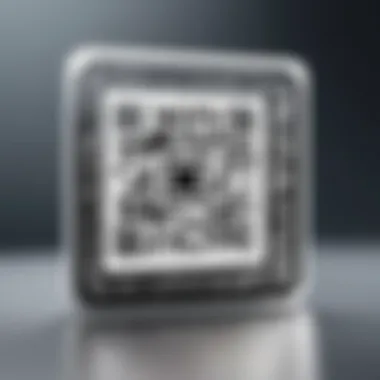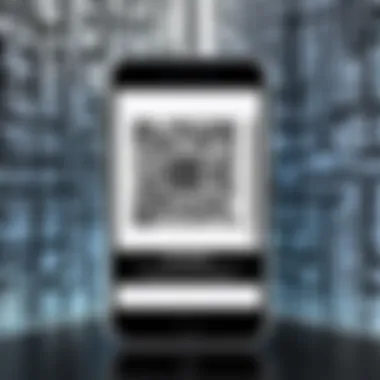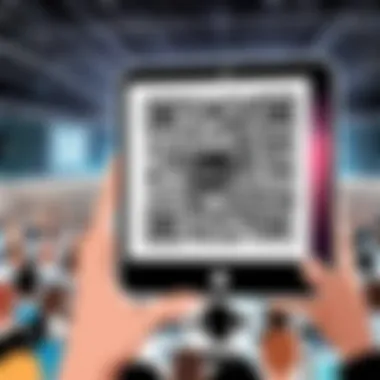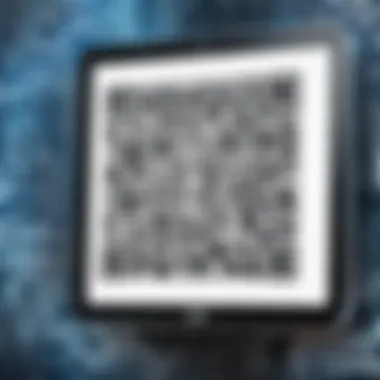Innovative Use of QR Codes in Music Playlists


Intro
In the ever-evolving landscape of technology, QR codes have emerged as a powerful tool for communication and information sharing. Traditionally used for marketing and advertising, these codes are now making their way into the music industry, particularly in playlist sharing. This article delves into the functionality and practical applications of QR codes in enhancing the sharing experience of music collections.
QR codes streamline the process of connecting artists to their audience, making it easier for listeners to discover new music. By scanning a code with a smartphone, users can access playlists instantly, reducing the friction often associated with finding and sharing songs. As the digital age continues to innovate, understanding how QR codes function in music playlists becomes essential for both creators and consumers alike.
Key Features
Simplified Sharing Process
The primary attribute of QR codes in music playlists is the simplified sharing process. Unlike conventional URLs, QR codes can be scanned, allowing users to access content directly. This is particularly useful at events, where concert-goers can scan a code to instantly receive curated playlists or links to their favorite tracks.
Enhanced User Experience
Integrating QR codes into music experiences enhances engagement. Users appreciate convenience in discovering music. With a quick scan, they can explore entire playlists, artist information, and related songs. This immediacy increases user connections to artists and their works, enriching the overall experience.
Versatile Applications
QR codes can be used in various contexts within the music industry. From album releases to promotional materials, the applications are wide-ranging. They can link to playlists in online platforms like Spotify, Apple Music, or YouTube, making them invaluable tools in modern music distribution.
Cost-Effective Marketing
Employing QR codes for music playlists presents a cost-effective marketing strategy. Artists and labels can create and distribute physical materials like posters or flyers containing these codes, facilitating an easy way for audiences to connect with their music. This method reduces reliance on traditional advertising channels, making music more accessible.
Practical Implementation
Creating a QR Code
Generating a QR code is straightforward. Various online tools allow anyone to create a code linked to their chosen playlist. Users simply input the URL of their playlist, customize the design if desired, and download the code. The generated code can be printed or shared digitally.
Scanning QR Codes
Most modern smartphones come equipped with QR scanning capabilities in their camera applications. If the camera detects a QR code, it will prompt users to take action. This process democratizes access to music playlists, as users only require a device to engage.
Examples of Practical Use
- Concert Merchandise: Artists can include QR codes on merchandise, facilitating direct music access post-purchase.
- Social Media Integration: Sharing QR codes via social media can increase followers and engagement by providing immediate access to music.
- Event Promotions: Events can utilize QR codes on tickets or promotional materials to connect attendees with event-specific playlists.
Ending
The incorporation of QR codes in music playlists represents an innovative fusion of technology and art. This integration not only simplifies the sharing process but also enhances user engagement and satisfaction. As technology continues to evolve, the use of QR codes is likely to become even more prevalent in the music industry, bridging connections between artists and listeners. Understanding these tools will prove beneficial for those looking to navigate and leverage contemporary music landscapes.
Understanding QR Codes
Understanding QR Codes is crucial when discussing their integration with music playlists. These codes provide a bridge between physical and digital worlds. By decoding these square-shaped patterns, users can gain instant access to music playlists with a simple scan. This technology is especially appealing in today's fast-paced society. It enhances interaction by allowing users to share music seamlessly. Furthermore, QR codes enable quick engagement with users, bypassing the traditional barriers of navigating multiple apps or websites.
Definition of QR Codes
QR Codes, short for Quick Response Codes, are a specific type of matrix barcode. Unlike traditional barcodes, they can store a larger amount of information. This includes not only URL links but also text and contact details. QR codes consist of black modules arranged on a white grid. Each code is unique, and their data can be read by a camera or scanner. People can utilize them for various purposes, including linking to music playlists, websites, or promotional content.


How QR Codes Work
The functionality of QR codes hinges on their ability to store data efficiently. When a user scans a QR code, a series of black squares are interpreted to retrieve the stored information. This process occurs through a method called error correction, which allows QR codes to be read even if part of them is damaged. To access a music playlist, users simply need to point their smartphone camera at the code. Once scanned, the user is redirected to the specified link, which can open songs or complete playlists on platforms like Spotify or Apple Music.
This entire process is quick, often taking only a few seconds. Moreover, QR codes do not require a special app. Most smartphones come equipped with the necessary technology right in the camera app. This accessibility makes them an ideal choice for sharing music.
Historical Context
The concept of QR codes originated in Japan in 1994. They were initially designed for tracking automotive parts. Over the years, their usage evolved, expanding into various fields, including marketing and payments. The introduction of smartphone cameras marked a turning point. As these devices became prevalent, the potential of QR codes flourished.
In the music industry, QR codes have gained traction in recent years. Artists and labels began using them on merchandise, concert posters, and social media. This integration allows fans to connect directly with their favorite music, bridging the gap between the physical and digital experience. The shift has been driven by the growing demand for instant access to music in an increasingly digital landscape.
QR Codes in the Music Industry
QR codes have emerged as an innovative tool in the music industry, offering diverse applications that enrich user experiences and streamline interactions between artists and fans. Their importance lies in the seamless integration of technology into music sharing, promoting greater accessibility and engagement. As the music landscape shifts towards digital consumption, QR codes play a pivotal role in connecting audiences with content in an efficient manner. By utilizing these codes, the industry can enhance promotional strategies, provide instant access to music, and integrate marketing campaigns effectively.
The Rise of Digital Music
The transition from physical music formats to digital has transformed how listeners access and enjoy music. The advent of streaming services like Spotify and Apple Music has changed consumption habits significantly. New technologies have facilitated this shift, allowing a personal library of songs accessible from anywhere with internet access.
The impact of digital music extends beyond just personal playlists. It has opened opportunities for artists to reach wider audiences without needing traditional distribution channels. This democratization of music means that listeners can now discover new artists through merely scanning a QR code on a poster or flyer. As such, the rise of digital music provides a fertile ground for the implementation of QR codes, enabling instant access and fostering a direct link between creators and their fans.
Current Usage of QR Codes
Ensuring easy access to music is crucial in a world where time is a valuable commodity. QR codes are finding various applications across the music industry. For instance, many artists include QR codes on concert tickets, promotional materials, or merchandise, directing fans to their latest playlists or social media profiles. This method simplifies the information-sharing process.
Moreover, during live performances, musicians may display QR codes on screens, encouraging the audience to scan and experience the setlist in real-time. The integration of QR codes with social media platforms also promotes sharing of music efficiently. The ability for individuals to share their playlists instantly enhances the social dimension of music listening.
Case Studies of Implementation
Several artists and companies have begun to successfully implement QR codes within their strategies. A notable example is the band The Chainsmokers, who included QR codes in their concert merchandise, leading to increased interaction with fans and opportunities for direct streaming of their music.
Similarly, labels like Universal Music Group are leveraging these codes on album covers, allowing listeners to access exclusive content such as behind-the-scenes videos or interviews with artists. These initiatives not only foster a deeper connection between the artist and the listener but also highlight the potential of QR codes in enhancing the overall experience of music consumption.
In summary, QR codes are carving out a significant niche in the music industry by connecting digital innovations with user engagement. As both fans and artists continue to explore their potential, QR codes promise to reshape how music is shared and experienced.
Creating Your Music Playlist with QR Codes
Creating a music playlist using QR codes offers a range of benefits, allowing for a more interactive and engaging experience. QR codes simplify the sharing process, making it easy for users to access a curated collection of music with a singular scan. People today seek streamlined methods to discover music. This method not only enhances convenience but also provides an innovative way to present and share musical tastes.
Selecting a Music Streaming Service
When it comes to creating a playlist with a QR code, the first step is to choose an appropriate music streaming service. There are several options available, each providing unique features. Services such as Spotify, Apple Music, and YouTube Music allow users to create, share, and customize playlists. Selection may depend on factors like user interface, catalog size, and personal taste in music.
Here are some key points to consider when selecting a service:
- Catalog Variety: Choose a service with a broad library of tracks.
- User-Friendliness: A simple interface helps in playlist creation.
- Sharing Options: Look for services that enable easy sharing through QR codes.
Generating a QR Code for a Playlist


Generating a QR code for your playlist is a straightforward task. After creating a playlist on your chosen streaming service, you will typically find an option to share or export it. This feature can be used to create a QR code. For example, Spotify allows users to share playlists and generates a unique QR code directly.
To create your QR code, follow these general steps:
- Open your playlist on the music streaming service.
- Select the Share option and find the QR code feature.
- Save or export the QR code to your device.
You can then print this QR code or share it digitally, allowing others to access your music collection quickly.
Best Practices for Designing QR Codes
While QR codes themselves are typically bare in design, there are best practices that can help in ensuring their effectiveness. Here are some suggestions:
- Size Matters: Ensure that your QR code is large enough to be scanned easily from a distance.
- Contrast: Utilize high contrast between the QR code and background for better visibility. A black QR code on a white background works traditionally well.
- Incorporate Branding: While keeping it functional, adding subtle branding elements can enhance thematic consistency.
- Test Before Distribution: Always test the QR code with different devices to ensure it works as intended.
"A well-designed QR code can enhance user interaction while keeping the functionality intact."
By considering these aspects, you improve the user experience, making it more likely that people will scan your code and enjoy your curated playlist.
Distributing QR Codes for Music Playlists
Distributing QR codes is a crucial aspect of utilizing this technology for music playlists. It enables users to share their curated music selections effectively, providing an easy access point for listeners. The methods of distribution can influence how well these codes are received and accessed. As more people become accustomed to using smartphones, integrating QR codes into various physical and digital spaces creates a seamless experience for sharing music.
The benefits are notable. QR codes can be shared in a variety of ways, appealing to diverse audiences across platforms. They provide an avenue for direct engagement, allowing potential listeners to scan a code and immediately access the desired playlist. This immediacy can enhance user experience and increase play counts for artists, promoting an interactive relationship between music creators and fans.
Physical Distribution Methods
Physical distribution of QR codes can occur in numerous ways, allowing immediate interaction in various settings. One effective method is through printed materials. Artists can design promotional flyers or posters featuring their QR codes. These can be placed in music venues, cafes, or local businesses. This strategy not only captures attention but also encourages immediate action from passersby.
Another method is through merchandise. Items like T-shirts or stickers with QR codes can serve as a conversation starter and a way to share music effortlessly. When utilized, these materials not only promote the music but also engage audiences in imaginative discussions.
Consider events where music is performed live. Distributing QR codes on wristbands or programs allows attendees to access playlists related to the performance instantly. This can transform a moment into an interactive experience, leaving a lasting impression on the audience.
Digital Distribution Strategies
Digital distribution is equally important and can open up new avenues for sharing music playlists. Social media platforms such as Facebook, Twitter, and Instagram are excellent channels for distributing QR codes. Artists can post images or videos of their codes alongside engaging content, encouraging followers to take action and explore new music. An emphasis on visually appealing designs can enhance the overall attraction.
Email marketing remains a strong tool. When sending newsletters or updates, embedding QR codes within the email provides a quick way for subscribers to access playlists. This direct line of communication enhances engagement, keeping the audience informed and involved.
Additionally, utilizing apps like Spotify or Apple Music allows integration of QR codes within their systems. This method simplifies the process for users; they can quickly scan the code within the app to access curated playlists without navigating away from their current music experience.
Benefits of Using QR Codes for Music Playlists
Integrating QR codes into music playlists brings several advantages. These benefits enhance usability and accessibility while fostering a deeper connection between artists and listeners. Below are some of the key elements that illustrate the significance of utilizing QR codes in music sharing.
Ease of Access
One of the most prominent advantages of using QR codes is the ease of access they provide. Traditional methods of sharing music, like sending links via text or email, can be cumbersome. With QR codes, users can scan a code to get immediate access to a playlist. This method minimizes the need to manually input URLs, reducing the chance of errors.
QR codes can be printed on various materials, such as concert tickets, posters, or merchandise. This gives fans a seamless way to explore new music, enhancing their concert experience or interaction with promotional materials. High-quality audio streaming becomes just a scan away, saving users time and effort.


Engagement and Interaction
QR codes are also a powerful tool for engagement. They can serve as a bridge between physical and digital worlds, creating a richer experience for users. For instance, when artists include QR codes in their promotional material, it allows for immediate access to their latest music.
This interactivity encourages fans to engage directly with the content. Scanning a code could lead to a new playlist, a special message from the artist, or an exclusive track. This not only promotes the artist’s music but also strengthens the relationship with their audience. In summary, QR codes foster dynamic interactions that traditional methods lack.
Cost-Effectiveness
Finally, using QR codes is a cost-effective method for distributing music playlists. Unlike traditional advertisement methods that may require significant investment in print media or digital marketing, QR codes can be generated and shared with minimal expense. Hosting a playlist on a streaming service is often free or low-cost.
Furthermore, QR codes do not require the creation of multiple physical products to showcase different songs or albums. One code can lead to a whole library or playlist, making it economical for creators and consumers alike. This approach allows broader distribution with less financial investment, empowering independent artists and small labels to reach audiences effectively.
Challenges and Limitations
Understanding the challenges and limitations surrounding QR codes in music playlists is essential for any user or producer in the music industry. While these digital tools offer significant benefits, they are not without issues. Addressing potential pitfalls ensures that both creators and consumers can maximize their experience with QR codes.
Technical Issues
Technical problems often hinder the seamless operation of QR codes. These include issues related to scanning devices, QR code generation, and linking. For instance, not all smartphones or devices are equipped to read QR codes effectively, especially older models. Additionally, the quality of the print can affect scannability. A blurred or poorly sized QR code may frustrate users trying to access playlists. Furthermore, the backend link should remain stable and accessible. If a link expires or changes, the QR code becomes useless. Maintaining consistency in the technical aspects is crucial for success. Addressing these technical issues requires thorough testing before wide distribution.
User Adaptation and Acceptance
User adaptability plays a significant role in the effectiveness of QR codes. While younger generations may quickly embrace new technologies, not all users share this enthusiasm. Some individuals may feel hesitant, preferring traditional methods to access music. The familiarity with using QR codes to share playlists varies widely among demographics, impacting their overall effectiveness. To counter this, education and promotion should accompany new implementations. Workshops or short tutorials on how to use QR codes can encourage a broader acceptance among all user groups. Understanding audience familiarity can guide the implementation process in a more effective manner.
Privacy Considerations
Privacy is a pressing concern when using QR codes, particularly in regards to data collection and user tracking. Some QR codes can lead to platforms that gather information about user behavior. Consumers often remain unaware of the potential data collection occurring when they scan a code. It is important for organizations to communicate their data policies clearly. Transparency fosters trust and enhances user experience. Failure to address these privacy issues may lead to skepticism towards QR codes and diminish their usability in music sharing. Users should always be informed about how their information will be used, ensuring responsible technology engagement.
"Efficient use of technology requires an understanding of its limitations."
In summary, while QR codes provide creative ways to share music playlists, knowledge of the associated challenges is vital. By confronting technical problems, enhancing user adaptation, and addressing privacy concerns, users can create a more effective and enjoyable musical experience through the integration of QR codes.
Future Trends in QR Codes and Music
The evolution of QR codes is poised to mark a significant shift in how we engage with music. As digital landscapes continuously transform, music playlists will benefit from the advancements in technology and user experience associated with QR codes. Understanding these future trends is crucial for music enthusiasts and professionals alike, as it can enhance the reach and impact of their music curation efforts.
The rise of smart devices and enhanced connectivity will boost the integration of QR codes. They provide a direct line to content and information, making them useful for sharing music across various platforms. This technological potential encourages the exploration of new ways to share playlists and engage with audiences.
Emerging Technologies
Innovations in QR code technology present exciting possibilities for the music industry. For instance, augmented reality (AR) can be integrated with QR codes, allowing users to experience a virtual concert or gain access to additional content, such as behind-the-scenes footage or artist interviews. This technology leverages the physical interaction with QR codes to unlock dynamic digital experiences.
Moreover, machines and tools that generate QR codes might evolve. Future advancements may include customizable designs that reflect an artist's branding or unique styles, creating a more personal connection between artists and listeners. Voice recognition technology could also play a role, enabling users to activate the scanning process through voice commands, enhancing user convenience.
As devices become more capable, QR codes could also facilitate immediate, seamless linking to streaming services or digital downloads. Greater security features could further enhance the reliability of these codes, helping to protect against unauthorized access or misuse of content.
Predictions for User Behavior
User behavior is likely to shift in tandem with technological advancements. As people become more accustomed to scanning QR codes in various contexts, their engagement with music will also change. Future audiences may prefer quick access to playlists through QR codes instead of traditional methods like typing out links.
The convenience of QR codes is predicted to boost their popularity among younger users who are already familiar with using smartphone technology. This demographic values speed and efficiency, making QR codes an ideal method for playlist sharing.
Additionally, the demand for interactive experiences is expected to grow. Users may become more inclined to scan codes that not only provide playlists but also interactive elements like voting for their favorite tracks or participating in social media challenges related to the music shared.
"The integration of QR codes into music playlists will reshape how audiences access and experience music while fostering deeper connections with artists."
In summary, the future trends in QR codes and music present promising developments that could redefine the music experience. As technology progresses, it is imperative for those involved in the music industry to adapt and leverage these changes to engage with their audiences more effectively.



